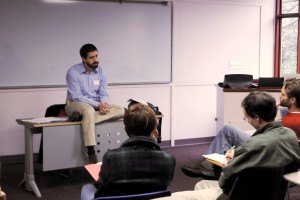GradSTEP recap: Discussion Leading
This blog post is written by William Hardin, a CFT Graduate Teaching Fellow. Bill led the Leading Effective Discussions session at GradSTEP on January 21, 2012. You can download the PowerPoint and handouts from this session.
Leading Effective Discussions
Getting students to talk, to really engage with one another, can be difficult. Many are unsure of how to participate in a college level discussion. Some students are reticent to speak for fear of being regarded as show offs. Others feel that they have nothing to offer or whatever they say may be greeted with silence or disapproval. So, prior to the first moment of class, barriers preventing honest and robust discussions have already been erected. It is our job as discussion leaders to help overcome those barriers and empower students to share their knowledge and experience in the classroom. One approach for discussion leaders to take toward overcoming preexisting barriers is to model the very attitudes and behaviors we would like our students to emulate.

On Saturday, January 21st at GradStep, I facilitated a workshop with the goal of helping participants reflect and consider their own perspectives on using discussion as pedagogical tool. We began with a sketch of what makes a good discussion and why discussion is important to college education. We often say that discussions are collaborative enterprises whose usefulness depends maximizing the resident knowledge, experience and perspectives of all the students in a classroom. Discussions should help bridge the gap between academic knowledge and life experience and allow students the intellectual space to connect their acquired learning with their own life journeys. By doing so, students take an active role in shaping their education and incorporating the perspectives of others as they form their own understanding of how the world works. It is in polite, but passionate and engaged conversation, that we develop the habits of civil society.
After providing a more abstract take on the value and purpose of discussion, we explored some useful practices for improving discussion. We discussed the value of creating a welcoming environment where students feel encouraged to speak and they feel their comments are appreciated and respected. We discussed creative ways of using the space of the classroom to our advantage to physically encourage discussion. We also spent some time on exploring the difficult balance discussion leaders must maintain between saying just enough to get the students engaged without dominating the conversation or interrupting good exchanges with unwelcome impromptu lectures.
The goal was not provide “tips and tricks” but to stake a claim for the importance of discussion and encourage participants to feel confident in exploring new techniques in their own teaching and to be able to identify the value and relevance of discussion to education. But we introduced a series of techniques and participants broke into groups and each presented various discussion engendering techniques, noting the pros and cons of each method. The goal here was to encourage participants to reflect and experiment with their own teaching and provide the resources for them to explore the “tips and tricks” that they feel are most useful in their own pedagogical context.
Participants were enthusiastic and many seemed relieved to find out that many of the anxieties and frustrations with past discussions were not unique to their own experiences. Gathered together in a room with fellow teachers, a real spirit of camaraderie was present in the workshop.

Leave a Response